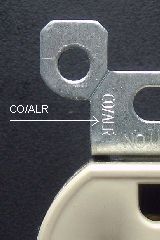Which Aluminum Wiring Solution?
Aluminum wiring can be replaced or repaired to effectively and permanently reduce the possibility of fire and injury due to failing (overheating) wire connections and splices. It is highly recommended that you hire a qualified electrician to perform this remediation. There are numerous potential solutions for the permanent repair of hazardous aluminum wire connections and splices.
All repair methods or products considered should be supported with satisfactory, documented evidence that they meet the following criteria
- Safe. The method or product must be safe and not increase the risk of fire or other hazards.
- Effective. The method or product must be effective and successfully eliminate or substantially mitigate the fire hazard.
- Permanent. The method or product must affect a permanent repair. Methods or products designed to address temporary or emergency repair situations, but which may fail over time, are not considered permanent.
Recommended Options for Repairing Aluminum Wiring
Rewire and Replace Aluminum Wiring
The ultimate solution to the aluminum wire problem for the homeowner is to have the aluminum replaced with copper. Although it is the ultimate solution, it is also the most costly and time consuming. Walls and ceilings may have to be cut to allow access to the wiring for removal and replacement.
Replacement of the aluminum branch circuit conductors with copper wire eliminates the primary cause of the potential hazards, the aluminum wire itself. Depending on the architectural style of your home and the number and locations of unfinished spaces (e.g., basements and attics), it may be relatively easy for a qualified electrician to rewire your home. A new copper wire branch circuit system would be installed, and the existing aluminum wire could be abandoned inside the walls. This is the best method available; but for many homes, rewiring with copper is impractical and/or prohibitively expensive.
Copper Tailing
The most common repair method involves adding a copper tail to the aluminum wiring using twist on connectors in a process commonly referred to as “pigtailing”. The effectiveness of using this method, like all repair methods, is dependent on the quality of products used and workmanship of the installation. It is important that these repairs be completed by qualified electricians using the proper connectors and treatment compounds. If done incorrectly “pigtailing” repairs may be prone to even more failures. However, when done properly, copper pigtails provide a cost effective approach to addressing the concerns associated with aluminum wiring.
Repair Methods That Are Not Recommended
Safe and permanent aluminum wiring solutions are not inexpensive. There are a number of temporary methods that seem like a cheaper option but which may have serious consequences in the future. Westridge Electric does not recommend the following repair ‘solutions’:
Doing Nothing – Leave Aluminum Wiring As Is
If there haven’t been any problems with the aluminum wiring, the homeowner may elect to do nothing. Failure of old–technology aluminum wiring is unpredictable and has greatly increased chance of reaching fire hazard conditions. The homeowner would continue to bear that risk. However, with homeowners’ insurance companies getting involved (in some areas), this may not be an option. Some insurance companies require either the aluminum be replaced with copper or that proper repairs are made. If the homeowner does neither, then the insurance company may raise the policy rates or may cancel the policy.
Crimp Connectors
[ezcol_1half]There are many other brands and types of crimp connectors — including those intended to be installed with a pliers-type of handtool — which are readily available to consumers at common retailers. These crimp connectors have not been evaluated for connecting copper and aluminum conductors.[/ezcol_1half] [ezcol_1half_end] [/ezcol_1half_end]
[/ezcol_1half_end]
“CO/ALR” Switches and Receptacles
The other repair recommended by the industry is to use switches and receptacles labeled “CO/ALR.” These devices have tin plated contact areas and large captive screw heads and are intended for direct connection to aluminum wire, although they can be used with copper or copper-clad wire. CO/ALR devices perform better with aluminum wire than non- CO/ALR devices when installed carefully and according to best electrical practices. However, CO/ALR wiring devices have failed in laboratory tests when connected to aluminum wire typical of that installed in existing homes. The test conditions simulated actual use conditions; no “overstress” type of testing was used. Further, CO/ALR connectors are not available for all parts of the wiring system (e.g., for the permanently wired appliances and ceiling mounted light fixtures). In the opinion of CPSC staff, CO/ALR devices must be considered, at best, an incomplete repair.

Book an Appointment today for an Aluminum Wiring Inspection and Cost Estimate or give Westridge Electric a call at 403-995-3547.


